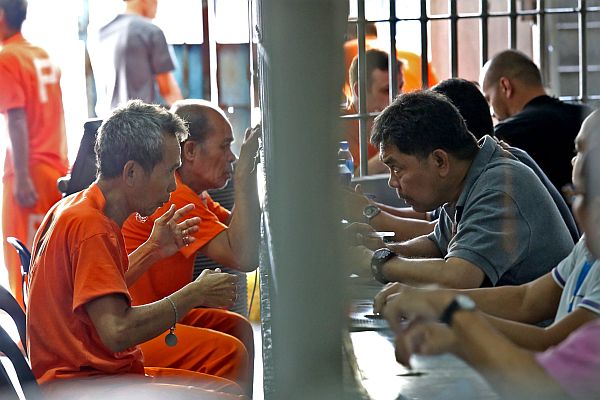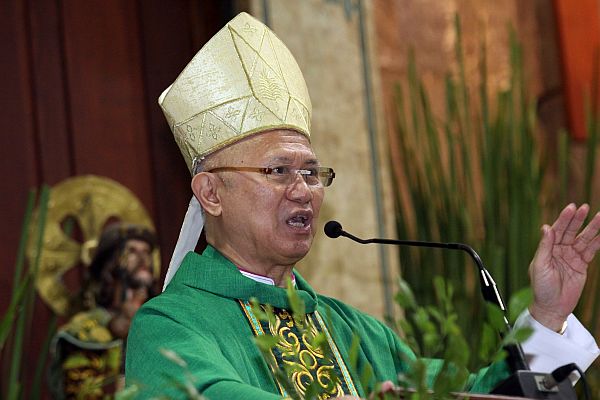
Commission on Human Rights investigators (right) start their inquiry by talking to the inmates at the Cebu Provincial Detention and Rehabilitation Center (CPDRC) to find out if the inmates’ rights were violated during PDEA’s greyhound operation early morning Tuesday.
(CDN PHOTO/JUNJIE MENDOZA)
Concerns that stripping naked CPDRC inmates violates human rights come to fore
Concerns over the stripping naked of inmates at the Cebu Provincial Detention and Rehabilitation Center (CPDRC) during a raid and herding them to a quadrangle at 1 a.m. prompted the Commission on Human Rights (CHR) to issue a directive en banc addressed to the CHR-7 office to investigate the jail raid last Tuesday.
This came amid the statement of Amnesty International calling it “cruel, inhuman and degrading treatment of prisoners.”
Vice President Leni Robredo also expressed alarm over the incident, saying this brought to fore several human rights issues, and stressed that it should not happen again. “Nakakabigla, nakakabahala (I was taken aback and worried),” she said.
“Maraming human rights issues ang kabahagi nito, meron tayong very specific na batas, the Anti-Torture Act na sinasabi na walang karapatan ang mga opisyal ng ating pamahalaan na kahit pa na yung biktima ay inmates sa isang kulungan na mag-undergo ng cruel, inhuman, degrading punishment na lalong magpapababa ng antas nila bilang tao (There are many human rights issues involved and we have specific laws that government officials have no right, even if the victims are jail inmates, to let them undergo cruel, inhuman and degrading punishment that debases them).”
However, Governor Hilario Davide III, who is also the warden of CPDRC, believes that making the inmates strip was just part of the process in conducting the greyhound operation.
“Para nako, wa may violation siguro. Lahi man gud ng environment sa jails nato, di lang sa CPDRC but tanan (For me, there was no violation. The environment in our jails is very different),” he said. Davide added that the inmates were not maltreated.
“They were just there and rounded up and asked to remove their clothing because we do not know what they are hiding underneath. So I don’t see anything that violates human rights or dignity. It’s a part of procedure,” he explained.
Investigation
Members of the Philippine Drug Enforcement Agency (PDEA) 7 augmented by police and soldiers swooped down on the provincial jail upon the request of Governor Davide who said he received reports that there were still drugs inside the facility.
CHR-7 chief investigator Leo Villarino said they received the directive from the CHR en banc to investigate the report and find out whether the rights of the inmates were violated.
“They may be detainees, but they still have the same rights as other human beings,” he told Cebu Daily News.
Accompanied by other investigators, Villarino visited the CPDRC at around 10 a.m. yesterday to talk with Roberto “Bobby” Legaspi, the officer in charge of the provincial jail — the home of the world-renowned dancing inmates.
Upon Legaspi’s approval, Villarino and the other CHR investigators talked to the inmates and asked them if they felt offended or humiliated by PDEA’s action to strip them off of all their clothes during the greyhound operation.
“We are here to know if there really was a need to let the inmates remove their clothes. What did they want to achieve? We are here to ask questions on what really happened,” he said.
Under the United Nations’ Standards for the Treatment of Prisoners, Villarino said stripping prisoners off of their clothes is allowed for security purposes during jail raids.
“But in the stripping naked of prisoners, intrusive searches are strictly prohibited,” he said.
Intrusive searches, he explained, involved “going into or touching the cavities or crevices of the body.” Villarino said he understood the decision of PDEA to let the inmates undress.
“We know how innovative our inmates are. We know for a fact that illegal items are placed inside the inner parts of the body,” he said.
After the investigation, Villarino said they hope to come up with clear guidelines on the conduct of inspections inside the jail.
Media
The CHR investigator also questioned the decision of some media entities to publish the photos of the naked inmates.
Villarino said he intends to hold a dialogue with mediamen to explain some protocols.
“Gory photos of dead people are blurred. Why don’t we use the same protocol for inmates who are still alive?” he said.
Sought for comment, Cebu Archbishop Jose Palma said letting inmates remove their clothes is “improper.”

PALMA
“Put yourself in the shoes of those people (inmates) and their families. Is that the best approach?” he told reporters.
PDEA-7 Director Yogi Filemon Ruiz said only the male inmates were asked to remove their clothes.
“The female detainees were just frisked by female agents of PDEA and were asked to stay in one area far from the male detainees,” he said.
Responsibility
Ruiz said he welcomed any investigation conducted by the CHR.
“I take full responsibility of what happened. I better face criticisms than having one of my agents get stabbed by the inmates,” he said in an interview.
Ruiz said law enforcers had to protect themselves from inmates who may have wanted to attack them using bladed weapons hidden under their shirts or pants.
During the greyhound operation last Tuesday, they confiscated a total of 68 bladed weapons at the CPDRC.
“That action (for prisoners to remove their clothes) was a mutual protection for both the agents and the inmates. If they are not wearing anything, then we’re sure that not a single bladed weapon is hidden from us. It was a judgment call on my part to let them remove their clothes,” he said.
CPDRC currently has about 3,600 inmates. During the raid, Ruiz said there were only 289 agents of PDEA, policemen and the army. Compared to the number of inmates, he said law enforcers had to assert themselves; otherwise, they might be overpowered by the inmates.
“I don’t think we violated the rights of the prisoners. The search was done in a peaceful and orderly manner. We didn’t humiliate the inmates. If ever there are those who interpret what we did as degrading the inmates, then I apologize. But there really was no intention to do so,” he added.
Ruiz added that he did not even call the media during the actual jail inspection in order not to violate the privacy of the inmates.
Disclaimer: The comments uploaded on this site do not necessarily represent or reflect the views of management and owner of Cebudailynews. We reserve the right to exclude comments that we deem to be inconsistent with our editorial standards.
